The Goddesses of Mesopotamia

I remember being introduced to the goddesses of Sumer for the very first time, sitting in a packed lecture hall. I can remember looking around at the bunch of lethargic students who wanted to be anywhere but a Mythology lecture, feeling much the same. It might have been an afternoon class, straight after lunch when we had dragged ourselves away from the lure of lounging around on the grass outside the café and trudged into the darkened lecture room.
Our middle-aged, bearded, cardigan wearing lecturer passed out a printed copy of an excerpt of a myth from 2500 BCE for us to read along with him. No one paid it any attention, ready to file it away with all the other forgotten pieces of paper. After waiting for us to settle he launched full throttle into the text, reading out loud:
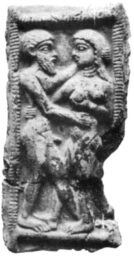
My vulva, the horn,
The Boat of Heaven,
Is full of eagerness like the young moon.
My untilled land lies fallow.
As for me, Inanna,
Who will plow my vulva?
Who will plough my high field?
Who will plough my wet ground?
As for me, the young woman,
Who will plough my vulva?
Who will station the ox there?
Who will plough my vulva?
Dumuzi replied: “Great Lady, the king will
plough your vulva.
I, Dumuzi, the King, will plough your vulva.”
Inanna: “Then plough my vulva, man of my heart! Plough my vulva!”
The verses reverberated through the gaping audience. He was reading from a 2,000 year old text called ‘The Courtship of Inanna and Dumuzi’ translated by Samuel Noah Kramer and Diane Wolkstein.
There was shuffling and a twitter of nervous laughter. No one knew where to look. My eyes nearly fell out of my head. I had to remember to close my mouth. I’d never read anything so clearly based on a woman’s sexual desire.
I was staggered by the words expressed so freely, the refrain forever tattooed on my mind. Who will plough my vulva? It is staggering to consider that society has regressed sexually.
It took me reading the sexually explicit texts of ancient Mesopotamia to discover that there had been a time when goddesses openly explored their sexual needs and desires.
This was the goddess Inanna, the most important female deity of ancient Mesopotamia in all periods. Inanna’s influence spanned thousands of years.
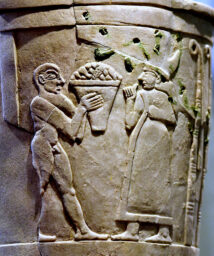
The Warka or Uruk Vase is an alabaster vessel discovered in the Sumerian city of Uruk dating to between 3200-3000 BCE, depicting a nude male worshipper presenting offerings to the goddess Inanna.
Inanna was originally worshipped in Sumer at least as early as the Uruk period (c.4000-3100 BCE). The temple of Eanna, meaning House of Heaven, in Uruk (modern-day Warkā), was built by 3500 BCE as her main cult centre. Inanna became patron goddesses of Uruk, one of the most important cities of the Sumerian world.
The imposing temple of Eanna had elaborately decorated mud-brick pillars eight-foot in diameter. Historians believe Mesopotamian monumental architecture was modelled after this temple. There were many shrines and temples dedicated to Inanna along the Tigris and Euphrates rivers.
After the conquest of King Sargon of Akkad (c. 2334-2279 BCE) her power strengthened thanks to devotees like King Sargon’s daughter, High Priestess Enhedu’anna, who composed many texts in her honour. They changed the Sumerian Inanna into the Akkadian Ishtar and her lover/consort went from being called Dumuzi to Tammuz.
Ishtar became one of the most widely venerated deities in the Sumerian pantheon, with temples across Mesopotamia. Inanna/Ishtar was worshipped by the Akkadians, Babylonians, and Assyrians.
Inanna was worshipped from the very beginning of Sumerian civilisation.
But our lecturer was not finished. He asked us to turn the page over. This time we were riveted, reading every juicy, metaphor laden word along with him:
Dumuzi sang:
“O Lady, your breast is your field.
Inanna, your breast is your field.
Your broad field pours out plants.
Your broad field pours out grain.
Water flows from on high for your servant.
Bread flows from on high for your servant.
Pour it on me, Inanna.
I will drink all you offer.”
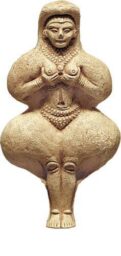
Inanna sang:
Make your milk sweet and thick, my bridegroom.
My shepherd, I will drink your fresh milk.
Wild bull, Dumuzi, make your milk sweet and thick.
I will drink your fresh milk.
Let the milk of the goat flow in my sheepfold.
Fill my holy churn with honey cheese.
Lord Dumuzi, I will drink your fresh milk.
(‘The Courtship of Inanna and Dumuzi’ (Inanna: Queen of Heaven and Earth: Her Stories and Hymns from Sumer’ by Samuel Noah Kramer and Diane Wolkstein)
Inanna is the goddess of love, beauty, sex, violence, and justice. Inanna was strong, powerful and sexually active. Rather than waiting to be chosen she chose. Inanna had sex for love and for enjoyment.
I love this image of Inanna from about 2000 BCE, made of bonded stone with a marble base, it is 29 cm (11.5 inches) high. Inanna was the strong and sexually assertive woman I never knew I needed in my life. She was openly lustful, desiring men to make love to her for pure pleasure as well as for love. Inanna is a no-holds-barred goddess who expressed herself in a way that is eyebrow-raising today.
I loved her instantly and carried her forthright nature deep within me. Inanna has stayed with me, teaching me through her texts and her incredible spirit.
Inanna was the strong and sexually assertive woman I never knew I needed in my life. She was openly lustful, desiring men to make love to her for pure pleasure as well as for love. Inanna was a no-holds-barred goddess who expressed herself in a way that is eyebrow-raising today. I loved her instantly and carried her forthright nature deep within me.
Life revolved around the Temples
During my travels, I have tip-toed around the edges of Mesopotamia, but really this culture is the one that intrigues me the most. The word Mesopotamia comes from the ancient words meso meaning middle, and potamos meaning river or stream.
Mesopotamia was once a thriving civilisation between the Tigris and Euphrates Rivers that once encompassed modern-day Iraq, the head of the Persian Gulf and south-east Türkiye, west Iran, north-eastern Syria and northern Kuwait.
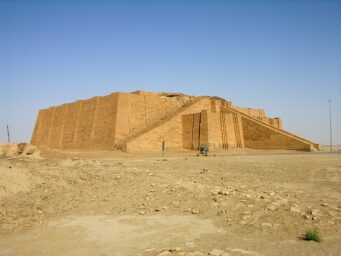
The earliest Sumerian cities began with a humble reed hut shrine. Slowly people settled around it to live. By 3000 BCE magnificent structures had replaced humble reed huts. Temples grew larger and larger, built on top of the earlier levels to become tiered ziggurats. This is the ruins of the ziggurat at Ur. Can you see the people at its base?
Each city was dedicated to their patron god or goddess who protected the people and was venerated in return. The city grew but so did the temple. The temple was the centre of industry and economy for their city.
In around the middle of the fourth millennium BCE, Sumer experienced an explosion of knowledge. The growing priest/esshood made dramatic advances in writing, mathematics, and the early stirrings of science of astronomy.
The temple and the priest/esses owned land, herds of animals, and most material property. In the Neolithic Period a high priestess was in charge. Judging from mythological accounts of the goddess and her earthly representative, the high priestess, Inanna oversaw or guided this counsel.
Offerings were delivered to the inner chamber of the temple. Meat was burned or cooked on the mud-brick altar in the centre of the giguna or holy of holies. The holy of holies was a secret stone chamber at the centre of the Temple.
The Pantheon
Political events influenced the makeup of the pantheon. The arrangement of the top of the pantheon could vary depending on time period and location. At the end of the third millennium BCE, Sumerian texts list approximately 3,600 deities.
In Sumerian religion, the most powerful and important deities in the pantheon were sometimes called the seven gods who decree: An, Enlil, Enki, Ninhursag, Nanna, Utu, and Inanna.
An was a supreme god, embodied by the sky, called Sky Father and King of the Gods. Enlil was a god of air, wind, storms, and earth. Enki was a god of war, wisdom, fresh water, intelligence, mischief, healing, creation, fertility, and art.
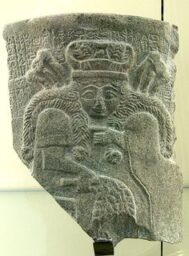
Ninhursag, meaning Lady of the Mountain, was a mother goddess associated with the creation of humanity itself as well as fertility, pregnancy, and childbirth. She is known as the Mother of the Gods and Mother of Men for her part in creating both divine and mortal entities.
Ninhursag replaced the earlier Mother Goddess, Nammu who was worshipped as early as the Dynastic III (2600-2334 BCE). Ninhursag was also known as Nintud/Nintur (Queen of the Birthing Hut) and, to the Akkadians, as Belet-ili (Queen of the Gods). Her other names include Makh, Ninmakh, Mamma, Mama, and Aruru.
Utu (Sumerian) or Shamash (Akkadian) was the Mesopotamian sun god. He was also the god of justice, truth, and protection. Many major deities in Sumerian mythology were associated with specific celestial bodies, such as Inanna with the planet Venus, Nanna was the Moon and Utu was believed to be the Sun.
Only one goddess, Inanna/Ishtar, stood amongst the principal gods who all had at least one consort and large complicated families.
While the great gods of the pantheon were worshipped by priest/esses at rituals in cultic centres, ordinary people had no direct contact with these deities. In their homes, they worshipped personal deities who were conceived as divine parents and were thought to be deities who could intercede on their behalf to ensure health and protection for their families.
I hope this helps to get a feel for the thousands of goddesses who are available for us to work with. This is the long lost her-story of goddess worship that was once integral to a feminine spiritual path.
Which place and period in her-story resonates for you?
Which goddess draws your curiosity?
Examples of goddesses of Mesopotamia: Ninhursag, Tiamat, Inanna/Ishtar, Ereshkigal, Nanshe, Shala.
Featured Image: This incredible image of Ishtar is on an Akkadian cylinder seal c.2334-2154 BCE, now housed in the University of Chicago. Inanna/Ishtar in full regalia stands triumphantly with one foot upon the back of her roaring lion. Her head is crowned by a headdress of multiple horns. Weapons sprout from her shoulders, while enormous wings appear from behind her back, suggesting both her martial and supernatural nature. In the sky beside her appears her eight-pointed star, emblematic of her manifestation as the Venus star and the star of Shamash.
